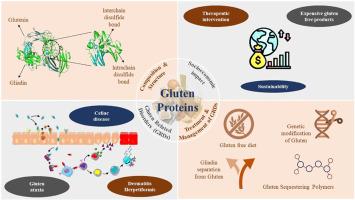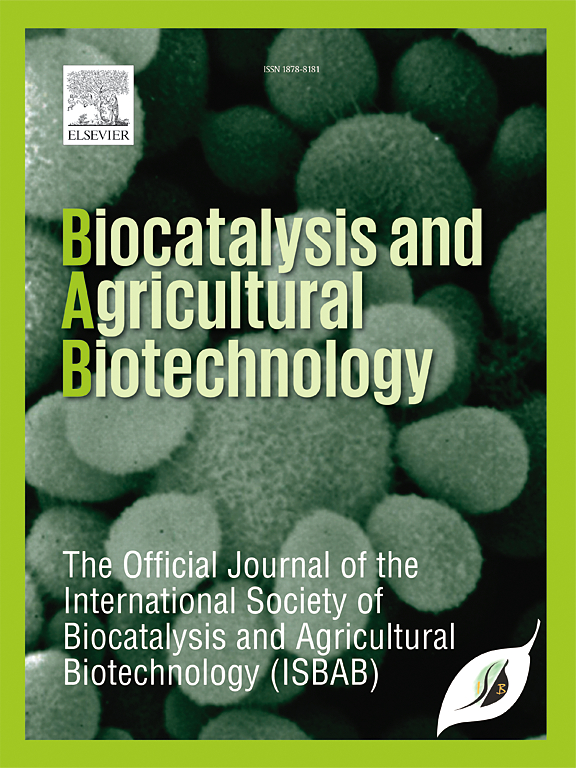麸质蛋白:全面回顾
IF 3.4
Q2 BIOTECHNOLOGY & APPLIED MICROBIOLOGY
引用次数: 0
摘要
本研究探讨了麸质蛋白之间错综复杂的关系、麸质蛋白作为食品配料的对手、麸质蛋白的应用以及麸质蛋白对各种麸质蛋白过敏症患者的影响。研究还深入探讨了麸质蛋白的多方面影响,从分子机制到社会经济影响。正在进行的研究探索了 HLA-DQ 限制性 CD4+ T 细胞在麸质相关疾病中的作用,揭示了 T 细胞反应随着疾病进展的动态性质。研究发现,一种特殊的麸质衍生蛋白片段--33聚合物脱酰胺麦胶蛋白肽(DGP)--可形成低聚物结构,损害肠道上皮细胞,使有害物质进入血液,引发易感人群的炎症和自身免疫。有前景的治疗方法包括转谷氨酰胺酶 2 抑制剂 ZED 1227,它已被证明可以防止肠道损伤,恢复麸质蛋白敏感患者的营养吸收。报告强调了麸质相关疾病造成的经济负担,包括直接和间接成本,如医疗保健服务、医疗管理、工作效率降低和错过教育机会等。据评估,由于麸质相关疾病的发病率上升以及人们认为对健康有益,无麸质产品市场也出现了大幅增长。然而,无麸质产品的价格较高,给人们,尤其是低收入群体带来了经济上的挑战。此外,无麸质产品的生产会对环境造成影响,因此需要及时采取可持续的采购和生产措施。因此,随着人们对无麸质产品需求的增加,这篇文献强调需要进一步研究和创新,以驾驭麸质蛋白和无处不在的加工食品市场之间错综复杂的动态关系,同时展望未来,治疗创新可能会消除完全无麸质生活方式的必要性,强调经济增长和健康之间需要平衡。本文章由计算机程序翻译,如有差异,请以英文原文为准。

Gluten proteins: A comprehensive review
This study explores the intricate relationship between gluten proteins, their adversaries as a food ingredient, their applications and their impact on individuals with various gluten-related sensitivities. It also delves into the multifaceted impacts of gluten, ranging from molecular mechanisms to socioeconomic effects. Ongoing research explores HLA-DQ restricted CD4+ T-cell roles in gluten-related disorders, revealing the dynamic nature of T-cell responses as the disorder progresses. A specific gluten-derived protein fragment, the 33-mer deamidated gliadin peptide (DGP), has been found to form oligomeric structures that can damage the gut epithelial cells, allowing harmful substances to enter the bloodstream and trigger inflammation and autoimmunity in susceptible individuals. Promising treatments include the transglutaminase 2 inhibitor ZED 1227, which has been shown to prevent intestinal damage and restore nutrient absorption in patients with gluten sensitivity. The economic burden of gluten-related disorders is highlighted to include direct and indirect costs, such as healthcare services, medical management, reduced work productivity, and missed educational opportunities. The gluten-free product market is also evaluated to have seen substantial growth due to the rising prevalence of gluten-related disorders and perceived health benefits. However, higher prices of gluten-free products pose financial challenges, particularly for lower-income groups. Additionally, the production of gluten-free products has environmental impacts that require a prompt need for sustainable sourcing and production practices. Therefore, as the demand for gluten-free products rises, this literature emphasizes the need for further research and innovation to navigate the intricate dynamics between gluten proteins and the ubiquitous processed food market, while envisioning a future with therapeutic innovations that may eliminate the necessity of complete gluten-free lifestyle, emphasizing the need for a balance between economic growth and health.
求助全文
通过发布文献求助,成功后即可免费获取论文全文。
去求助
来源期刊

Biocatalysis and agricultural biotechnology
Agricultural and Biological Sciences-Agronomy and Crop Science
CiteScore
7.70
自引率
2.50%
发文量
308
审稿时长
48 days
期刊介绍:
Biocatalysis and Agricultural Biotechnology is the official journal of the International Society of Biocatalysis and Agricultural Biotechnology (ISBAB). The journal publishes high quality articles especially in the science and technology of biocatalysis, bioprocesses, agricultural biotechnology, biomedical biotechnology, and, if appropriate, from other related areas of biotechnology. The journal will publish peer-reviewed basic and applied research papers, authoritative reviews, and feature articles. The scope of the journal encompasses the research, industrial, and commercial aspects of biotechnology, including the areas of: biocatalysis; bioprocesses; food and agriculture; genetic engineering; molecular biology; healthcare and pharmaceuticals; biofuels; genomics; nanotechnology; environment and biodiversity; and bioremediation.
 求助内容:
求助内容: 应助结果提醒方式:
应助结果提醒方式:


